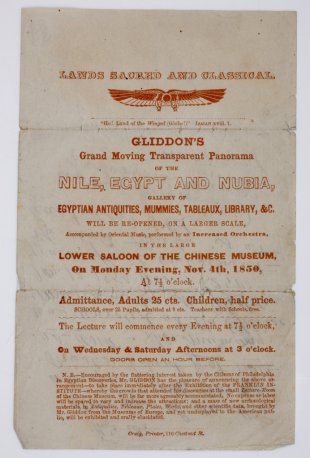Handbill for Gliddon's Panorama of the Nile
Mummy-Mania
Handbill for Gliddon's Panorama of the Nile [ edit ]
George Gliddon had these small handbills printed by Jared Craig in Philadelphia as advertisements for the change in location of the Panorama of the Nile from an unnamed location to the lower saloon of the Chinese Museum where there would be more room for the show, collection of antiquities, and an increased orchestra that would play oriental music. The exhibit featured four mummies, one of which had been unwrapped in Boston.
Some visitors one evening were startled to hear words coming from the coffin of the mummy unrolled in Boston. “Open the box! Open the box!” echoed throughout the room. There followed a dialogue between the observers and the mummy, which covered the decline of the Egyptian empire and strongly hinted that the ancient inhabitants thereof had migrated to Mexico to continue their pyramid-building habits. This was, of course, a hoax, perpetrated by famous ventriloquist Bobby Blitz, who reaped such fun from his folderol that he later incorporated a mummy in his performances.
George Gliddon had obtained the transparent (i.e. translucent) Panorama of the Nile from Joseph Bonomi in London in 1849, where it had been the sensation of the year. Gliddon was always on the lookout for things to enhance his lectures on Egyptomania, and this was a great find. The Panorama was in essence a long, translucent, painted scroll which wound and unwound on rollers, was lighted from behind, and depicted the ancient and modern wonders of Egypt along the entire length of the Nile. Among the artists who had a hand in its creation were Henry Barren, James Pakey, John Martin, E. Corbould, and C.H. Rigall, who did the painting after eyewitness drawings by Bonomi. Bonomi sold the original to Gliddon, but had a copy made for himself that he continued to exhibit.
Gliddon first exhibited his Panorama in New York, then subsequently in Boston and Philadelphia, finally ending in New Orleans. In order to enhance the Philadelphia public’s experience, Gliddon advertised that he would unwrap two mummies during the course of his lectures in the same manner as he had already unwrapped one in Boston (Got-Thoti-Ankh). One of these mummies was Got-Mut-As-Ankh (who was in an elaborately painted coffin), and the other an unnamed child.
It was not unusual at mummy unwrappings for the audience to want to take home souvenirs of their experience. One unknown attendee carefully preserved this little announcement, as well as several small pieces of mummy linen (averaging 3 by 8 cm.) and some beads from the unwrapping of Goth-Mut-As-Anch in a scrap of unidentified Philadelphia newspaper. The beads have long since disappeared (they were probably made of clay and faience and simply crumbled to dust), but the accompanying note on the back of the handbill reads, “this is cloth from the swathing or unwrapping of the High Priestess named Got-Mut-as-Anch. This mummy was unroled [sic] at the Chinese Museum by Mr. Gliddon Jan. 17, 1850 [i.e., 1851] about 2500 years after its embalmment—the cloth therefore is at least that old.” No other remnants of the unwrapping have yet come to light.
Date
1850
Dimensions
H. 18cm, W. 18cm
Material
Paper
Museum
American Antiquarian Society
Accession Number
BDSDS 1850 (Record ID 467227)














